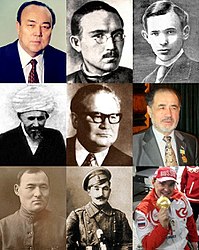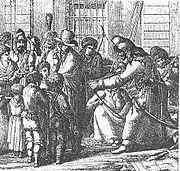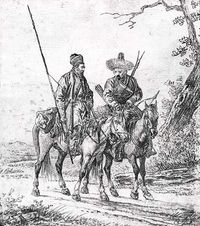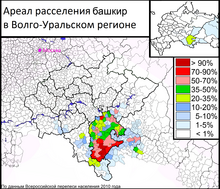| Revision as of 19:16, 12 August 2015 edit173.228.104.153 (talk) →Middle Ages← Previous edit | Revision as of 06:12, 30 August 2015 edit undoCyberbot II (talk | contribs)Bots, Pending changes reviewers469,529 edits Rescuing 1 sources, flagging 0 as dead, and archiving 0 sources. (Peachy 2.0 (alpha 8))Next edit → | ||
| Line 23: | Line 23: | ||
| |region2 = {{flag|Kazakhstan}} | |region2 = {{flag|Kazakhstan}} | ||
| |pop2 = 17,263 | |pop2 = 17,263 | ||
| |ref2 = <ref> {{ |
|ref2 = <ref> {{wayback|url=http://www.stat.kz/p_perepis/Documents/Нац%20состав.rar |date=20130914220455 }}</ref> | ||
| |langs = ], ]<ref name="языки">{{cite web|url=http://www.gks.ru/free_doc/new_site/perepis2010/croc/Documents/Vol4/pub-04-08.pdf |format=PDF |title=8. НАСЕЛЕНИЕ НАИБОЛЕЕ МНОГОЧИСЛЕННЫХ|publisher=Gks.ru |accessdate=2015-03-16}}</ref> | |langs = ], ]<ref name="языки">{{cite web|url=http://www.gks.ru/free_doc/new_site/perepis2010/croc/Documents/Vol4/pub-04-08.pdf |format=PDF |title=8. НАСЕЛЕНИЕ НАИБОЛЕЕ МНОГОЧИСЛЕННЫХ|publisher=Gks.ru |accessdate=2015-03-16}}</ref> | ||
| |rels = ] | |rels = ] | ||
Revision as of 06:12, 30 August 2015
For other uses, see Bashkir (disambiguation).| This article needs additional citations for verification. Please help improve this article by adding citations to reliable sources. Unsourced material may be challenged and removed. Find sources: "Bashkirs" – news · newspapers · books · scholar · JSTOR (April 2012) (Learn how and when to remove this message) |
Template:Contains Cyrillic text
Ethnic group
| |
| Total population | |
|---|---|
| approx. 2 million | |
| Regions with significant populations | |
| 1,584,554 | |
| 17,263 | |
| Languages | |
| Bashkir, Russian | |
| Religion | |
| Sunni Islam | |
| Related ethnic groups | |
| Turkic peoples | |
The Bashkirs (Template:Lang-ba) are a Turkic people indigenous to Bashkortostan, extending on both sides of the Ural Mountains, on the place where Europe meets Asia. Groups of Bashkirs also live in the republic of Tatarstan, Perm Krai, Chelyabinsk, Orenburg, Tyumen, Sverdlovsk, Kurgan, Samara and Saratov Oblasts of Russia, as well as in Kazakhstan, Ukraine, Uzbekistan and other countries.
Most Bashkirs speak the Bashkir language, which belongs to the Kypchak branch of the Turkic languages and share cultural affinities with the broader Turkic peoples. In religion the Bashkirs are mainly Sunni Muslims of the Hanafi madhhab.

Ethnonym
There are several theories regarding the etymology of the name "Bashqort".
- The historian and archaeologist Mikhail Artamonov suggests that it is a corruption of the name of the Bušxk' (or Bwsxk), an Iranian-speaking Scythian tribe that previously lived in the area now called Bashkortostan.
- Ethnologist R. G. Kuzeev defines the ethnonym as "bash" — "main, head" and "qort" — " clan, tribe".
- According to the theory of 18th-century ethnographers V. N. Tatishchev, P. I. Richkov, and Johann Gottlieb Georgi, the word "Bashqort" means "wolf-leader of the pack" (bash — "main",qort — "wolf").
- In 1847, historian V. S. Yumatov suggested the meaning as "beekeeper, beemaster".
- In 1885, another Russian historian and ethnologist, A. E. Alektorov, suggested that "Bashqort" means "distinct nation".
- Famous Turkologist N. A. Baskakov believed that the word "Bashqort" consists of two parts: "badz(a)" – brother-in-law" and "(o)gur" and means "Ugrics' brother-in-law".
- Ethnologist N. V. Bikbulatov's theory states that the term originates from the name of legendary Khazar warlord Bashgird, who was dwelling with two thousand of his warriors in the area of the Jayıq river.
- According to Douglas Morton Dunlop the word "Bashqort" comes from "beshgur, bashgur" which means "five tribes". Since "SH" in the modern language complies with "L" in Bulgar, the ethnonyms "Bashqort(bashgur)" and "Bulgar" are equivalent.
- Historian and linguist András Róna-Tas believes the ethonym "Bashkir" is a Bulgar Turkic reflex of the Hungarian self-denomination "Magyar" (Old Hungarian: "Majer").
History

Middle Ages

Early records on the Bashkirs are found in medieval works by Sallam Tardzheman (9th century) and Ibn-Fadlan (10th century). Al-Balkhi (10th century) described Bashkirs as a people divided into two groups, one inhabiting the Southern Urals, the second group living on the Danube plain near the boundaries of Byzantium——therefore – given the geography and date – referring to either Danube Bulgars or Magyars. Ibn Rustah, a contemporary of Al Balkhi, observed that Bashkirs were an independent people occupying territories on both sides of the Ural mountain ridge between Volga, Kama, and Tobol Rivers and upstream of the Yaik river.
Achmed ibn-Fadlan visited Volga Bulgaria as a staff member in the embassy of the Caliph of Baghdad in 922. He described them as a belligerent Turk nation. Ibn-Fadlan described the Bashkirs as nature worshipers, identifying their deities as various forces of nature, birds and animals. He also described the religion of acculturated Bashkirs as a variant of Tengrism, including 12 'gods' and naming Tengri – lord of the endless blue sky.
The first European sources to mention the Bashkirs are the works of Joannes de Plano Carpini and William of Rubruquis in the mid 13th century. These travelers, encountering Bashkir tribes in the upper parts of the Ural River, called them Pascatir or Bastarci, and asserted that they spoke the same language as the Hungarians.
During the 10th century, Islam spread among the Bashkirs. By the 14th century, Islam had become the dominant religious force in Bashkir society.
By 1236, lands of Bashkortostan were incorporated into the empire of Genghis Khan.
During the 13th and 14th centuries, all of Bashkortostan was part of the Golden Horde. The brother of Batu-Khan, Sheibani, received the Bashkir lands to the east of the Ural Mountains, at that time inhabited by the ancestors of contemporary Kurgan Bashkirs.
During the period of Mongolian-Tatar dominion, the features of Kipchaks a part of Bashkirs. Under the Golden Horde, separate Mongolian elements. During the 17th and 18th centuries – a part of the Kalmyks and Middle Asian Sarts. From the 16th to the 20th centuries, various groups of Tatars.
After the breakup of the Mongol Empire, the Bashkirs were separated between Nogay horde and Kazan and Siberian khanates, founded in the 15th century. Trans-Ural Bashkirs were subordinated to the Siberian Khanate.
Early modern period

In the late 16th and early 19th centuries Bashkirs occupied the territory from the left bank of the Volga on the south-west to the riverheads of Tobol in the east, from the river Sylva in the north, to the middle stream of the Yaik in the south, in the Middle and Southern Urals, in Cis-Urals, including Volga territory and Trans-Urals.
In the middle of the 16th century, Bashkirs joined the Russian state. Previously they formed parts of the Nogayskaya, Kazan, Sibir, and partly, Astrakhan khanates. Charters of Ivan the Terrible to Bashkir tribes became the basis of their contractual relationship with the tsar’s government. Primary documents pertaining to the Bashkirs during this period have been lost, some are mentioned in the (shezhere) family trees of the Bashkir.
The Bashkirs rebelled in 1662–64 and 1675–83 and 1705–11. In 1676, the Bashkirs rebelled under a leader named Seyid Sadir or 'Seit Sadurov', and the Russian army had great difficulties in ending the rebellion. The Bashkirs rose again in 1707, under Aldar and Kûsyom, on account of ill-treatment by the Russian officials.
1735 Bashkir War


The third insurrection occurred in 1735, at the time of the foundation of Orenburg, and it lasted for six years. From at least the time of Peter the Great there had been talk of pushing southeast toward Persia and India. Ivan Kirillov drew up a plan to build a fort to be called Orenburg at Orsk at the confluence of the Or River and the Ural River southeast of the Urals where the Bashkir, Kalmyk and Kazakh lands join. Work was started at Orsk in 1735, but by 1743 'Orenburg' was moved about 250 km west to its present location. The next planned step was to build a fort on the Aral Sea. This would involve crossing the Bashkir country and then the lands of the Kazakh Lesser Horde, some of whom had recently offered a nominal submission.
Kirillov's plan was approved on May 1, 1734 and he was placed in command. He was warned that this would provoke a Bashkir rebellion, but the warnings were ignored. He left Ufa with 2,500 men in 1735 and fighting started on the first of July. The war consisted of many small raids and complex troop movements, so it cannot be easily summarized. For example: In the spring of 1736 Kirillov burned 200 villages, killed 700 in battle and executed 158. An expedition of 773 men left Orenburg in November and lost 500 from cold and hunger. During, at Seiantusa the Bashkir planned to massacre sleeping Russian. The ambush failed. One thousand villagers, including women and children, were put to the sword and another 500 driven into a storehouse and burned to death. Raiding parties then went out and burned about 50 villages and killed another 2,000. Eight thousand Bashkirs attacked a Russian camp and killed 158, losing 40 killed and three prisoners who were promptly hanged. Rebellious Bashkirs raided loyal Bashkirs. Leaders who submitted were sometimes fined one horse per household and sometimes hanged.
Bashkirs fought on both sides (40% of 'Russian' troops in 1740). Numerous leaders rose and fell. The oddest was Karasakal or Blackbeard who pretended to have 82,000 men on the Aral Sea and had his followers proclaim him 'Khan of Bashkiria'. His nose had been partly cut off and he had only one ear. Such mutilations are standard Imperial punishments. The Kazakhs of the Little Horde intervened on the Russian side, then switched to the Bashkirs and then withdrew. Kirillov died of disease during the war and there were several changes of commander. All this was at the time of Empress Anna of Russia and the Russo-Turkish War (1735–1739).

Although the history of the 1735 Bashkir War cannot be easily summarized, its results can be.
- The Russian Imperial goal of expansion into Central Asia was delayed to deal with the Bashkir problem.
- Bashkiria was pacified in 1735–1740.
- Orenburg was established.
- The southern side of Bashkiria was fenced off by the Orenburg Line of forts. It ran from Samara on the Volga east up the Samara River to its headwaters, crossed to the middle Ural River and followed it east and then north on the east side of the Urals and went east down the Uy River to Ust-Uisk on the Tobol River where it connected to the ill-defined 'Siberian Line' along the forest-steppe boundary.
- In 1740 a report was made of Bashkir losses which gave: Killed: 16,893, Sent to Baltic regiments and fleet: 3,236, Women and children distributed (presumably as serfs): 8,382, Grand Total: 28,511. Fines: Horses: 12,283, Cattle and Sheep: 6,076, Money: 9,828 rubles. Villages destroyed: 696. As this was compiled from army reports it excludes losses from irregular raiding, hunger, disease and cold. All this was from an estimated Bashkir population of 100,000.
Later, in 1774, the Bashkirs, under the leadership of Salavat Yulayev, supported Pugachev's Rebellion. In 1786, the Bashkirs achieved tax-free status; and in 1798 Russia formed an irregular Bashkir army from among them. Residual land ownership disputes continued.
The Bashkirs lived between the Kama, Volga, Samara and Tobol Rivers. The Samara River extends from the hairpin curve of the Volga east to the base of the Urals. The Tobol is east of the Upper Ural River. Orsk is where the Ural turns westward. The Belaya River with the town of Ufa cuts through the center.
Demographics

The ethnic Bashkir population is estimated at roughly 2 million people (2009 SIL Ethnologue), of which about 1.4 million speak the Bashkir language, a Turkic language of the Kypchak group. The Russian census of 2002 recorded 1.38 million Bashkir speakers in the Russian Federation. Most Bashkirs are bilingual in Bashkir and Russian.
The 2010 Russian census recorded 1,172,287 ethnic Bashkirs in Bashkortostan (29.5% of total population).
About 50% of Bashkirs are Muslim, 25% are unaffiliated, 11% are atheist, and 2% are pagan. There are also about less than 1% Protestant and Catholic Bashkirs.
Culture
| It has been suggested that Music in the Republic of Bashkortostan be merged into this article. (Discuss) Proposed since April 2012. |

The Bashkirs are predominantly Sunni Muslims of the Hanafi madhhab. The Bashkirs traditionally practiced agriculture, cattle-rearing and bee-keeping. The half-nomadic Bashkirs wandered either the mountains or the steppes, herding cattle.
Bashkir national dishes include a kind of gruel called öyrä and a cheese named qorot. Wild-hive beekeeping can be named as a separate component of the most ancient culture which is practiced in the same Burzyansky District near to the Shulgan-Tash cave.
«Ural-batyr» and «Akbuzat» are Bashkir national epics. Their plot concerns struggle of heroes against demonic forces. The peculiarity of them is that events and ceremonies described there can be addressed to a specific geographical and historical object –the Shulgan-Tash cave and its vicinities.
Genetics
Genetic studies have revealed that most Bashkir males belong to Y-DNA Haplogroup R1b, which is otherwise concentrated in Western Europe. This has lent support to theories such as:
- the "Kurgan hypothesis", i.e. that the original homeland of the Proto-Indo-Europeans lay immediately west of the Ural Mountains, in or near present-day Bashkortostan, and;
- Mikhail Artamonov's suggestion that the Bashkirs are descended from the Bušxk', a Scythian tribe that became culturally "Turkified" (including a process of language replacement), during the Turkic migrations of the first millennium CE.
Notable Bashkirs
- Ildar Abdrazakov, opera singer
- Rustem Khamitov, president of Bashkortostan
- Murtaza Rakhimov, first president of Bashkortostan
- Zeki Velidi Togan, historian, Turkologist, and leader of the Bashkir revolutionary and liberation movement
- Salawat Yulayev, Bashkir national hero
- Irek Zaripov, biathlete and cross-country skier
- Tagir Kusimov, was a Soviet military leader.
- Zaynulla Rasulev, was a Bashkir religious leader in the 19th and early 20th century.
- Kadir Timergazin, was also a Soviet petroleum geologist, the first doctor and professor of geological-mineralogical sciences from the Bashkirs, an honored scientist of the RSFSR.
- Mustai Karim, was a Bashkir Soviet poet, writer and playwright. He was named People's poet of the Bashkir Autonomous Soviet Socialist Republic (1963), Hero of Socialist Labour (1979), and winner of the Lenin Prize (1984) and the State Prize of the USSR (1972).
- Babich Shaikhzada, was a Bashkir poet, writer and playwright. Member of the Bashkir national liberation movement, one of the members of the Bashkir government (1917–1919).
- Kharrasov Mukhamet – was a rector of the Bashkir State University (2000–2010), Ph.D in physics, Honorary worker of Higher professional Education of Russia (2002).
References
- Lewis, M. Paul (ed.) (2009). "Ethnologue: Languages of the World, Sixteenth edition". Dallas, Tex.: SIL International.
{{cite web}}:|author=has generic name (help) - "ВПН-2010". Perepis-2010.ru. Retrieved 2015-03-16.
- Archived 2013-09-14 at the Wayback Machine
- "8. НАСЕЛЕНИЕ НАИБОЛЕЕ МНОГОЧИСЛЕННЫХ" (PDF). Gks.ru. Retrieved 2015-03-16.
- ^ Peter B. Golden, Haggai Ben-Shammai & András Róna-Tas, The World of the Khazars: New Perspectives, Leiden/Boston, Brill, 2007, pp. 422.
- This account of the 1735 war is a summary of Donnelly's book (see sources.)
- "Главная страница проекта «Арена» : Некоммерческая Исследовательская Служба "Среда"". Sreda.org. Retrieved 16 March 2015.
- "Numerical analysis" (JPG). Sreda.org. Retrieved 2015-03-16.
- See, for example: Will Chang, Chundra Cathcart, David Hall, & Andrew Garrett, 'Ancestry-constrained phylogenetic analysis supports the Indo-European steppe hypothesis', Language, vol. 91, no. 1 (March) 2015, p. 196.
Sources
- Frhn, "De Baskiris", in Mrn. de l'Acad. de St-Pitersbourg, 1822.
- J. P. Carpini, "Liber Tartarorum", edited under the title "Relations des Mongols ou Tartares", by d'Avezac (Paris, 1838).
- Semenoff, "Geographical-statistic Dictionary of Russian Empire", 1863.
- Florinsky, in "Vestnik Evropy" magazine, 1874.
- Katarinskij, "Dictionnaire Bashkir-Russe", 1900.
- Gulielmus de Rubruquis, "The Journey of William of Rubruck to the Eastern Parts of the World", translated by V.W. Rockhill (London, 1900).
- William of Rubruck's "Account of the Mongols", 1900.
- Chisholm, Hugh, ed. (1911). "Bashkirs" . Encyclopædia Britannica (11th ed.). Cambridge University Press.
- Alton S. Donnelly, "The Russian Conquest of Bashkiria 1552–1740": Yale Univ. Press, 1968.
- Summerfield, Stephen Cossack Hurrah: Russian Irregular Cavalry Organisation and Uniforms during the Napoleonic Wars, Partizan Press, 2005 ISBN 1-85818-513-0
External links
- Bashkirs at congress of Hungarians on YouTube
- Bashkir folk dance "Kahim Tura" on YouTube
- Culture of Bashkirs
- Bashkir folk-tales and legends
- The Bashkir nation: history pages Template:Ru icon
- Photos of Bashkirs and their life in funds of the Library of Congress
- Photos of Bashkirs and their life in funds of the Peter the Great Museum of Anthropology and Ethnography (the Kunstkamera)
| Muslims in Europe | |||||||||||||
|---|---|---|---|---|---|---|---|---|---|---|---|---|---|
| Majority |
| ||||||||||||
| Minority | |||||||||||||
| Ethnic groups in Russia | |||||||||||||
|---|---|---|---|---|---|---|---|---|---|---|---|---|---|
| Titular nationalities | |||||||||||||
| Indigenous peoples |
| ||||||||||||
| Other ethnic peoples |
| ||||||||||||
| Unrecognized peoples | |||||||||||||
| Assimilated peoples | |||||||||||||